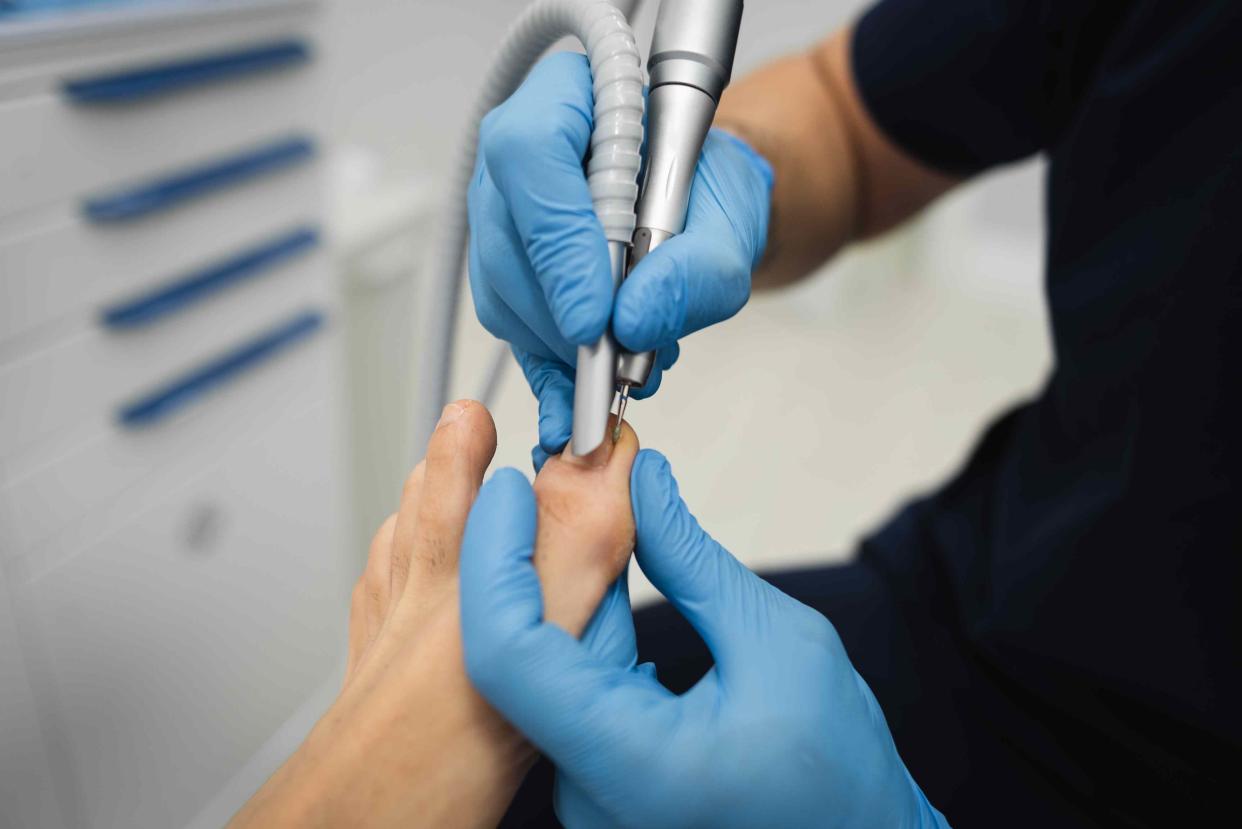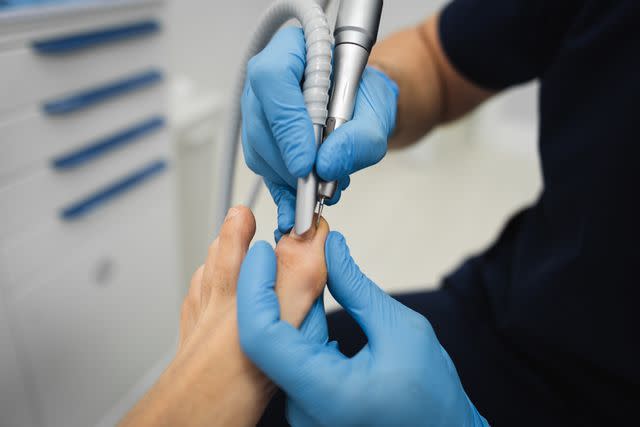How to Find the Toenail Fungus Treatment That Will Work for You

pedro arquero / Getty Images
Fungal toenail infections (onychomycosis) usually don't go away on their own and can be challenging to treat. Treatments such as topical or oral medications can help clear up the fungus, but treatment can take up to a year to fully work. Treatment works best when started early.
Medications are effective for about half of people who use them to treat fungal nail infections.
This article will discuss medications used to treat fungal toenail infections, other treatments available, and factors that can influence healing.

pedro arquero / Getty Images
Toenail Fungus Treatment: At Home
Fungal toenail infections usually require treatment, but there are measures you can take to help prevent contracting or spreading them. These may include:
Keep your feet clean, cool, and dry
Wear footwear in public places, including water-suitable shoes at public pools, showers, or gyms
Don't share tools such as nail clippers
If visiting a nail salon, make sure your state's cosmetology board licenses them, they are clean, and that they sterilize all instruments after each use
Choose socks that wick perspiration and shoes that allow your feet to breathe
Wear properly-fitting shoes that don't press on your nail
Use an antifungal foot spray or powder daily
Keep your nails trimmed (straight across)
Go without shoes to give your feet some air when possible
Clean shower or rub basin daily, either with vinegar in a spray bottle or a daily shower cleanser
Nail polish or artificial nails may cover the look of the fungus but will not get rid of the infection.
Some home remedies and natural treatments—such as tea tree oil—have shown some promise as an antifungal outside of the body. Still, most of these treatments have not been adequately studied in human trials to consider them proven effective for fungal toenail infections.
Toenail Fungus Treatment: Drugstore Options
Over-the-counter (OTC) products, such as creams and ointments, are not usually effective toenail fungus treatments.
OTC topical antifungal products are widely available and may help improve the nail's appearance, but prescription or medical treatments are typically needed to cure the infection.
Toenail Fungus Treatment: Prescription
Prescription treatments for a fungal toenail infection may include topical or oral medications.
These are outlined below .
Topical Treatments
Topical medications that may be used to treat toenail fungus may include:
Jublia (efinaconazole)
Kerydin (tavaborole)
Penlac (ciclopirox)
Amorolfine
Tioconazole
Topical treatments are usually first-line treatments because they carry less risk, but they must be applied daily and can take up to a year to notice significant improvement. Filing the nail's surface may make it easier for the medication to get through the nail, closer to the fungus.
How Effective Are Prescription Topical Toenail Fungus Treatments?
Prescription topical medications have about a 30% success rate, but the infection may return.
Oral Treatments
Oral medications can be more effective for treating toenail fungus than topical medications, with studies showing a success rate of about 55% to 70% after 10 months. The fungus returned within a few months in 15% to 20% of cases.
Oral antifungal medications may include:
Lamisil (terbinafine)
Sporanox (itraconazole)
Fluconazole
Posaconazole
A course of oral antifungal medication for a fungal toenail infection is about three months.
These medications can affect the liver, so your healthcare provider will monitor you for liver damage using lab tests while you are on these medications.
These medications can also interact with several other medications, as well as alcohol and the sun. Talk to your healthcare provider about whether the benefits outweigh the risks.
Underlying Foot Conditions That Can Be Exacerbated By Toenail Fungus
Some medical conditions make developing a fungal toenail infection more likely, including:
Fungal skin infections, especially on the foot, such as tinea pedis (athlete's foot), or ringworm
Trauma to the foot or nail, or a foot deformity
Diabetes
Weakened immune system
Venous insufficiency
Peripheral arterial disease
Peripheral neuropathies
Combining Toenail Fungus Treatments
In some cases, treatments for fungal toenail infection may be combined—such as topical and oral medications. This can be, but is not always, more effective than using one treatment alone.
Medication may also be combined with medical procedures to improve the medication's effectiveness. It can be challenging for topical medication to penetrate the nail, and some measures are being explored to help with drug delivery. These include:
Filing the nail
Using a small electrical current
Does Any Toenail Fungus Treatment Work Fastest?
Treatment for a fungal toenail infection should be individualized as the length of treatment is only one consideration, and not all treatments are appropriate for everyone.
Topical treatments are often used for 12 months or longer, preferably until the healthy nail has fully grown in. Oral medications may have a shorter course of treatment, but it will still take time for new, healthy nails to grow in.
Factors That Can Prolong Healing
Treatments work best when started early. If the infection has spread or becomes more severe, it may be harder to treat.
Health conditions such as diabetes, immunosuppression, or poor circulation can make it more likely for the fungus to return.
Having mixed infections and not completing the treatment plan as directed can also contribute to a recurrence.
Summary
Fungal toenail infections can be difficult to treat and often return.
Available treatments include prescription topical medications and prescription oral medications. These treatments may take months to over a year to fully work. Oral medications tend to be more effective than topical, but they also come with more risks, such as the potential for liver damage.
OTC and home treatments are not usually effective for fungal toenail infections. Still, measures such as keeping feet cool and dry, wearing footwear in public, and not sharing tools such as nail clippers, can help prevent getting and spreading fungal toenail infections.
It is important for people with diabetes or with weakened immune systems to see their healthcare provider if they notice any nail problems, to prevent possible serious complications.

